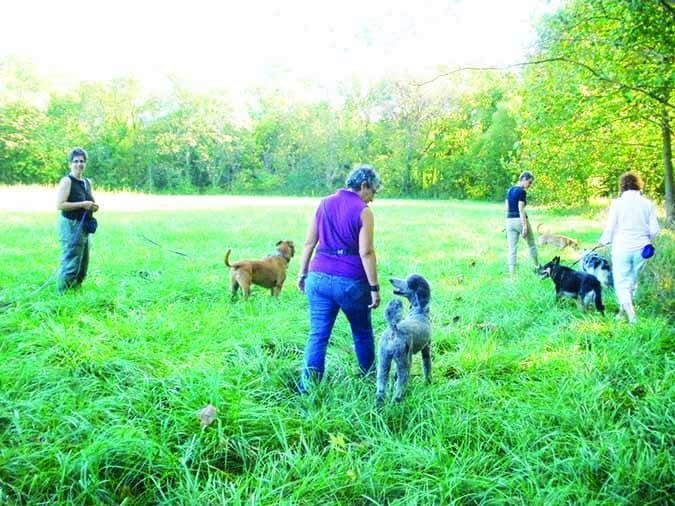Not to be outdone by the veterinary profession (See “How to Decipher Veterinary Code,” WDJ October 2013) or even dogs themselves (“Dog Certifications and Titles,” January 2014), the dog training and behavior profession also boasts a mind-boggling array of letters that may appear at the end of a trainer’s name. In some cases, the initials identify a person with considerable education and experience with canine behavior, but others indicate little more than membership in a dog-training organization, so it pays to know what those letters mean!

You may be surprised to discover that there are no educational, experience, training, skill, certification, or licensing requirements for anyone to call themselves a dog trainer or behaviorist in the United States. None. Zip. Zero. Nada. Your plumber could decide to hang out a shingle and start training dogs tomorrow, even if he or she has never touched or even seen a dog in his or her entire life.
Fortunately, there are scores of excellent educational opportunities for animal training and behavior professionals to increase their skills and knowledge, and many do, in fact, attend courses and seek various kinds of certification in the field. In fact, the number of qualified, well-educated training and behavior professionals has increased dramatically since the 1990s.
True Animal Behaviorists
While the media tends to refer to anyone who will comment on any animal’s behavior as an “animal behaviorist,” there is growing agreement among ethical behavior and training professionals that the term “behaviorist” should be reserved for those in the field who have advanced degrees in behavior and/or veterinary medicine and behavior. Those who don’t have such degrees and who wish to show respect to degreed behaviorists use terms like “behavior consultant,” “behavior counselor,” and “behavior professional” to describe what they do. That said, plenty of people who offer services in training and behavior disregard that courtesy.
DACVB: At the top of the behaviorist food chain is the “veterinary behaviorist” – a veterinarian who meets the rigorous qualifications set by the American College of Veterinary Behavior (ACVB) and passes the two-day veterinary board exam in behavior. These board-certified specialists are known as diplomates; a diplomate of the ACVB = DACVB. One who calls himself a veterinary behaviorist without this credential is practicing veterinary behavioral medicine without a license and is subject to prosecution.
In addition to passing the board exam, the requirements include the equivalent of an internship; a conforming residency at an approved university program, or a non-conforming training program which was mentored and approved by ACVB; a supervised behavioral caseload (the first 25 clinical cases are seen with the mentor present, 25 of the next 50 cases are seen under the supervision of the mentor, close supervision is required for the first 200 cases); authoring a scientific paper published in a peer-reviewed journal based on the candidate’s own research; and writing three peer-reviewed case reports.
Given the requirements, it’s understandable that there are fewer than 100 DACVBs in the world, most in the United States and a handful in Canada.
CAAB: Next in line is the Certified Applied Animal Behaviorist (CAAB). In order to become a CAAB, one must meet the qualifications set by the Animal Behavior Society (ABS).
There are two different possible paths to acquisition of this title. The first requires a Phd (doctoral degree) in a biological or behavioral science with an emphasis on animal behavior, and five years of professional experience.
The second path requires a doctorate in veterinary medicine plus two years in a university-approved residency in animal behavior and three additional years of professional experience in applied animal behavior.
Other requirements of this second path include: demonstrating a thorough knowledge of the literature, scientific principles, and principles of animal behavior; submitting original contributions or original interpretations of animal behavior information; showing evidence of significant experience working interactively with a particular species as a researcher, research assistant, or intern with a Certified Applied Animal Behaviorist prior to working independently with the species in a clinical animal behavior setting; attending and presenting a contributed talk or poster at an ABS Annual meeting prior to applying for certification; and meeting all the requirements for an Associate Certified Applied Animal Behaviorist (see next).
ACAAB: The Associate Certified Applied Animal Behaviorist is the next rung down the ladder. Don’t let the “Associate” fool you; the requirements for this level of certification are still stringent: First, the applicant must obtain a Master’s degree from an accredited college or university in a biological or behavioral science with an emphasis in animal behavior. The degree should include a research-based thesis. Coursework must include 30 semester credits in behavioral science courses, including 9 semester credits in ethology, animal behavior, and/or comparative psychology; and 9 semester credits in animal learning, conditioning, and/or animal psychology.
Next, the candidate must provide evidence of a minimum of two years of professional experience in applied animal behavior; show evidence of significant experience working interactively with a particular species (such as a researcher, research assistant, or intern working with a certified applied animal behaviorist) prior to working independently with the species in a clinical animal behavior setting; attend and present a contributed talk or poster at an ABS annual meeting prior to applying for certification; and must also provide a minimum of three letters of recommendation, one from a Certified ABS member and one from a regular ABS member affirming the applicant’s professional experience in the areas listed above. There are about 50 CAABs and ACAABs combined.
With fewer than 100 certified behaviorists in the entire United States (many of whom do not work with companion animals), the dog population would be seriously underserved if there were not other qualified behavior and training professionals to be found. Fortunately, a number of organizations created to further the education of dog trainers have emerged in the past few decades.

APDT: Recognizing the need for professionalism in the dog training field, in 1991 British veterinary behaviorist Ian Dunbar founded the Association of Pet Dog Trainers, intended as a forum for trainers to network with each other and provide educational opportunities. APDT, which was recently renamed the Association of Professional Dog Trainers, held its first annual educational conference in Orlando, Florida, in 1993.
The annual conference continues to this day, joined by frequent webinar offerings. While the APDT itself does not certify trainers nor are its members necessarily committed to force-free training, this organization did launch the CCPDT in 2001 (see below), which has certified more than 2,000 training and behavior professionals worldwide. With more than 5,000 members, APDT is the largest dog training membership organization in the world.
AVSAB: The American Veterinary Society of Animal Behavior (AVSAB) is a group of veterinarians and research professionals who share an interest in understanding behavior in animals. Founded in 1976, AVSAB is committed to improving the quality of life of all animals and strengthening the bond between animals and their owners. Membership in this organization is open to all veterinarians, veterinary students, and non-veterinarians who have a Phd in animal behavior or a closely related field.
Membership in AVSAB is not a certification, and so is not a statement of member skills or qualifications in behavior work.
CCPDT: The Certification Council for Professional Dog Trainers was the first national certification body for dog trainers. Until the creation of the CCPDT in 2001, there was no nationally available certification process for dog trainers in this country. Unlike many other certifications, CCPDT tests are monitored, and the testing processes are standardized. The CCPDT administered its first test September 28, 2001, during the APDT educational conference in New York.
CCPDT is not a membership organization; you do not join in order to become a certificant. CCPDT requires its certificants to abide by a Code of Ethics and adhere to a humane hierarchy in their behavior and training practices. There are currently more than 2,500 certificants in one of the three existing certifications (a fourth certification is in the development stage):
CPDT-KA: The Certified Professional Dog Trainer, Knowledge-Assessed, must pass a comprehensive written exam; submit confirmation of at least 300 hours experience in dog training within the past five years; have a high school diploma or GED equivalent; and submit three references (from a veterinarian, a dog training client, and a colleague in the behavior and training profession). There are currently more than 2,400 CPDT-KAs.
CPDT-KSA: The Certified Professional Dog Trainer, Knowledge and Skills Assessed, must hold a CPDT-KA credential and, additionally, pass a video skills examination of him or herself training four different skills as designated by the CCPDT, one skill each to four different dogs not living with or previously trained by the candidate. There are about 120 CPDT-KSAs.
CBCC-KA: The Certified Behavior Consultant, Canine, Knowledge Assessed, must pass a comprehensive written exam; submit records of 500 hours in canine behavior consulting on fear, phobias, compulsive behaviors, anxiety, and aggression within the previous five years; or hold a Master’s Degree or Doctorate in psychology, social work, a biological sciences field, or a life sciences field with 300 hours in canine behavior consulting on fear, phobias, compulsive behaviors, anxiety, and aggression within the previous three years; and submit five references. There are about 75 CBCC-KAs.
IAABC: The International Association of Animal Behavior Consultants was founded in 2004 in recognition that the practice of assisting the public with companion animal behavior problems was a growing field that encompassed many different professionals: veterinarians, animal trainers, animal shelter employees, and academics, as well as practicing consultants who didn’t always fit neatly into one of the aforementioned categories.

The goal of the IAABC is to standardize and support the practice of companion animal behavior consulting, while providing resources for pet owners needing advice. The organization has nearly 400 members throughout the world (not all members are dog behavior consultants). IAABC members work to minimize the use of aversive stimuli and maximize the effective use of reinforcers to modify animal behavior. The LIMA (least intrusive and minimally aversive) principle is used as a general rule. You must be a member of IAABC to be certified. There are about 375 Certified and Associate Certified members on the IAABC rosters.
CDBC: The IAACP offers certifications for professionals who do behavior work with a variety of different species. The Certified Dog Behavior Consultant must: document a minimum of three years and 500 hours experience in animal behavior consulting with client present; complete 400 hours minimum of relevant coursework, seminars, and mentorship; submit three written case studies; submit written discussion of four case scenarios; answer questions regarding terminology, techniques, behavior assessment, and history taking; and posses a minimum educational level of high school diploma or GED. Veterinary Behaviorists, ACAABs, and CAABs are granted membership with the submission of three applicable case studies and the application fee.
IACP: The International Association of Canine Professionals was founded in 1999 to develop and promote the highest standards of professional and business practice among canine professionals. IACP offers three different certifications; you must be a member of IACP to be certified. The IACP has about 65 certified members (not all IACP members are certified).
CDT: Professional members of the IACP and Associate members who have been members for six months and have at least two years’ experience as a professional trainer can take the Certified Dog Trainer exam. The CDT exam is intended to test an applicant’s basic level of skills to provide the general public with a standard of expectation for what constitutes a “basic level” of expertise. Candidates must submit three evaluation forms filled out by past clients; three letters of reference; copies of handouts used in training, sample intake/registration forms; and three case studies.
CDTA: The intent of the Certified Dog Trainer – Advanced (CDTA) exam is to verify a high level of competence on the part of the candidate. The CDTA must have held the CDT title for at least one year and have a minimum of five years experience training professionally. The CDTA candidate must either train three dogs in front of an IACP-CDTA Evaluator (and also make provisions to have the training videotaped to a DVD), or present a video of himself training three dogs without an evaluator present and submit the DVD to IACP for evaluation.
PDTI: A candidate for Professional Dog Training Instructor (PDTI) must have held the CDT title for one year, and have a minimum of 250 hours of instruction as head or lead dog trainer for group or private classes within the past five years. The exam tests the applicant’s knowledge, experience, and instructing skills relevant to teaching people to train their dogs. The candidate must also submit three letters of reference; forms, handouts, workbooks, homework sheets, and reading lists used in training; videos of the candidate instructing clients; and answers to 12 essay questions.
NADOI: The National Association of Dog Obedience Instructors was founded in 1965 when a small group of highly experienced dog trainers gathered together and resolved to promote modern, humane training methods, and at the same time elevate the standards of the dog obedience instructing profession. To accomplish these goals, it was decided that members of the organization should be designated as having attained certain skills and knowledge of dog training and obedience instructing.
NADOI Certified membership requirements include: at least five years’ experience in dog obedience training; at least two years as a full-charge instructor; past experience working with a minimum of 100 different dogs; submission of training hours (group instructors must have taught at least 104 class hours; private instructors 288 hours). Also, each applicant must submit a written essay that enables evaluation of his knowledge of general dog behavior, ability to deal with specific training problems, knowledge and use of training methods, and teaching and training skills.
PPG: The Pet Professional Guild is a membership business league for individuals and professional pet industry businesses with the common goal of furthering the public’s education and awareness of force-free dog training and pet care methods, techniques, and state of research in dog training and pet care, and promoting the common interest of spreading force-free dog training and pet care methods to the pet industry.
The PPG provides professional registry, representation, and education to force-free pet care providers and the public, with an emphasis on building collaboration among force-free pet trainers and professional pet care providers, thereby improving the business conditions and promoting the common interests of force-free professionals. The PPG does not offer certifications.
TDF: The Truly Dog Friendly group is an online list of more than 350 training and behavior professionals who are committed to using dog-friendly methods. TDF defines dog-friendly methods as reward-based rather than force-based. Dog-friendly trainers do not use shock collars (e-collars), nor do they use coercion, intimidation, or pain. Instead, they teach with a gentle, fair approach so that dogs truly will enjoy learning and form a trusting bond with their owners. TDF does not certify trainers.
There are many training schools that offer certificate courses. While a student who completes one or more courses from these schools may be granted a “certification” title, this type of certification means only that the student passed the course. While some of the courses are very comprehensive, true professional certification tests a broad body of knowledge, not just the knowledge taught in a specific course.

ADT: Jean Donaldson’s Academy for Dog Trainers aims to further aversive-free, science-based dog training by making an academically rigorous program available to anyone, no matter where they live, at an affordable cost. This is a comprehensive on-line program that can typically be completed in one to two years.
CASI: The Companion Animal Sciences Institute provides advanced, science-based professional development education in the animal behavior, training, behavior change programming, fitness, and nutrition in an online format. It is the position of CASI that animal friendly, positive reinforcement-based methods are the most efficient and effective, and least intrusive and risk-laden methods to use in animal training and behavior, and most conducive to facilitating the human-animal bond. Certificate credentials offered by CASI include:
Cert. PDTST: The Certificate of Professional Dog Training Science and Technology program is a rigorous program that helps students upgrade and develop skills for a career in dog training. Coursework covers the principles of learning and technology of dog training, with hands-on skill practice.
Cert. SRW: The Diploma of Shelter and Rescue Work certificate program addresses many aspects of working in the dog sheltering and rescue environment. Coursework explores the principles of behavior, behavioral assessment strategies within the shelter environment, training and behavior modification techniques for shelter and rescue environments, disease risk management, environmental enrichment and emotional health management of dogs in shelters, the adoption process itself, and shelter and rescue organization operation.
Dip. ABST: The Diploma of Animal Behavior Science and Technology program addresses key topics in behavior modification and management protocols, including the principles of behavior; tactics, strategies, and procedures in non-coercive animal training; functional assessment; behavior modification protocols; professional activities; and professional ethics. Students carry out hands-on training with their own companion animal and engage in a problem behavior resolution project.
KPACTP: The Karen Pryor Academy (KPA) Dog Trainer Professional program takes an innovative approach to developing and supporting outstanding positive reinforcement trainers who teach the general public. Graduates of the academy are Karen Pryor Academy Certified Training Partners (KPACTP). The six-month course combines online learning with hands-on teaching from experienced teachers in the field.
NK9SDT: In 1981 the National K-9 Learning Center established its School for Dog Trainers (NK9SDT), with the mission of offering interested individuals the skills and knowledge to pursue careers within the field of professional dog training. The school uses what it calls a “balanced” approach to training, meaning that the tools and methods used are not necessarily based in positive reinforcement.
CPT: Certified Professional Trainers are graduates of the NK9SDT’s six-week Master Trainer course.
PPAWS: Peaceable Paws (PPAWS), launched in 1996, is my own training business and trainer academy, with a mission to foster harmony between the human and non-human animals of our world. PPaws Academies are intensive, hands-on, six-day courses; graduates of multiple academies are PMCTs (Pat Miller Certified Trainers). The Peaceable Paws Academy has graduated more than 300 trainers since its inception. All PMCTs commit to using force-free methods. There are three levels of certification: PMCT1 through PMCT3.

TRS: The Tom Rose School, in business for 40 years, offers intensive residential programs and course certifications that cover everything from basic obedience to canine competition, guard dog, and service dog training. The school uses a “balanced” approach to training, meaning the tools and methods used are not restricted to those based in positive reinforcement. TRS offers several courses with certifications for graduates: a 16-week Associate Dog Trainer (ADT) course; Professional Dog Trainer (PDT) program, which has the same length and content as the ADT, but with standards set higher; a 12-week Master Dog Trainer (MDT); and Advanced Master Dog Trainer (AMDT) course, which is available by invitation only.
VSPDT: Victoria Stilwell Positively Dog Training is a network of professional dog trainers committed to promoting positive reinforcement methodologies. VSPDT doesn’t currently offer a dog trainer school, but has a licensing process for currently practicing professional dog trainers who meet certain criteria and qualifications, including employing only positive reinforcement dog training; avoiding dominance-based alpha-hierarchy methodologies; and undergoing a dog training evaluation by Victoria and her team.
Far More Dog Professions Out There
This is by no means a complete list of the alphabet jungle that comprises the world of dog behavior and training; there are undoubtedly more organizations that offer education and/or credentialing for trainers. Just keep in mind that, as in any line of work, not every graduate of a particular program is equally skilled. The letters they choose to put behind their name can give you a rough idea of how much and what kind of education they’ve had, that’s all.
If you are looking for a training or behavior consultant to help you with your dog, you still have to use due diligence: watch the person work with dogs and teach classes, ask for references, etc., the way you would research anyone who you will allow to work with your dog, whether she bears an impressive set of letters behind her name or not.
Please Note: Whole Dog Journal supports training and behavior modification methods that follow science-based positive reinforcement protocols. Not all of the programs discussed in this article meet that standard.







Might want to update. PPG does offer certifications through their pet professional accreditation board.